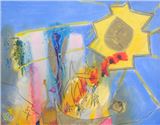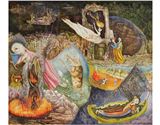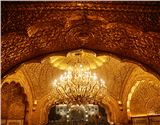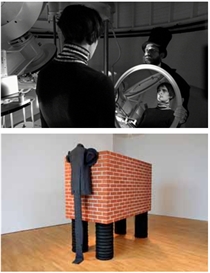Vasco Araújo and Javier Téllez
"Mais que a vida" (Larger than Life) was an ambitious exhibition (traveling to Spain's Museo de Arte Contemporáneo de Vigo, where it is on view through January 9, 2011)
Michéle Faguet / ARTFORUM
Oct 01, 2010

Vasco Araújo and Javier Téllez
FUNDAÇÀ0 CALOUSTE GULBENKIAN
"Mais que a vida" (Larger than Life) was an ambitious exhibition (traveling to Spain's Museo de Arte Contemporáneo de Vigo, where it is on view through January 9, 2011) that surveyed the prolific trajectories of Portuguese artist Vasco Araújo and New York- and Berlin-based Venezuelan artist Javier Téllez, with works that shared a penchant for literary, cinematic, and autobiographical references. Trained as an opera singer, Araújo takes the language of melodrama to a point of excess that is both playful and melancholic, while Téllez's collaborations with mental patients and other marginalized groups - in film works that deconstruct the epistemological premises of alrerity and exclusion - clearly resonate with his background as the son of two psychiatrists.
Among the works on display by Téllez were La Passion de Jeanne d'Arc (Rozelle Hospital), 2004, a two-channel video installation featuring female psychiatric patients in Sydney that addressed the historical gendering of pathological behavior; Letter on the Blind for the Use of Those Who See, 2007, a black-and-white 16-mm film showing an encounter between an elephant and six blind New Yorkers who performed a loose reenactment of an Indian parable featuring blind men and an elephant in what Téllez describes as an attempt at "haptic cinema"; and Caligari and the Sleepwalker, 2008, a wryly humorous sci-fi version of the Robert Wiene classic, cowritten and acted by patients of Berlin's Vivanres clinic. Exhibited for the first time was Orinocerante de Dürer (Dürer's Rhinoceros), 2010, a film set in the former Miguel Bombarda psychiatric hospital in Lisbon - a panoptical institution in operation until 2001 - and produced in collaboration with outpatients from another local hospital. In the film, an embalmed rhinoceros is shuttled around the interior courtyard while patients act out fictional scenarios within their cramped, dark cells. A man gently guides two pet mice through an architectural replica of his prison while a female voice off-camera recites a passage from Kafka's "The Burrow"; a woman dressed as a torero sits on her bed listening to a fado record until the performers she has visualized in her mind appear before her. With this work, Téllez continues to move in the direction of narrative filmmaking that is visually seductive while minutely aware of its ideological effects.
Araújo's former incarnation as a stage performer is manifest in such works as Dilettino, 2001, in which the artist shouts out both voices of the Don Giovanni duet "Là ci darem la mano" (There We Shall Join Hands) as the camera dramatically circles him, reducing the background to a flash of color; and Far de Donna, 2005, which imagines a contemporary castrato - shown rehearsing in a master class - whose mother lost her voice and recounts the episode in sign language with narrative adornment revolving around the Oedipal scenario of an absent father. Among Araújo's most recent works is Mulheres d' Apolo (Apollo's Women), 2010, filmed at a ballroom dancing school and dance hall in Lisbon. With passages extracted from The Trojan Women by Euripides as well as original monologues about the abandonment, abuse, and isolation suffered by its female narrators, the video documents an evening dancing event frequented by middle-aged couples and elderly single women. As the band churns out its repertoire of jazzed-up show tunes such as "Bali Ha'i," the dancers move around a camera that shifts between vantage points displaying bodies that are lifeless and robotic. The exception is a woman in a silver gown with a youthful black bob, blissfully swirling about in a solitary dance as the protagonist of a banal tragedy that ends with Araújo himself dressed as her double, delivering a final soliloquy in a gesture of pure theatricality that parodies the sad story one might have hoped for.
- Michèle Faguet
COPYRIGHT: Copyright Artforum Inc. Oct 2010. Provided by Proquest- CSA, LLC. All Rights Reserved. Only fair use as provided by the United States copyright law is permitted.
PROQUEST-CSA, LLC- MAKES NO WARRANTY REGARDING THE ACCURACY, COMPLETENESS, OR TIMELINESS OF THE LICENSED MATERIALS OR ANY WARRANTY, EXPRESS OR IMPLIED.








